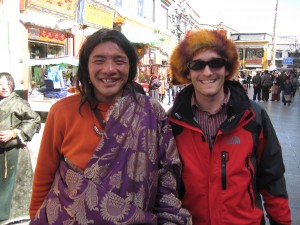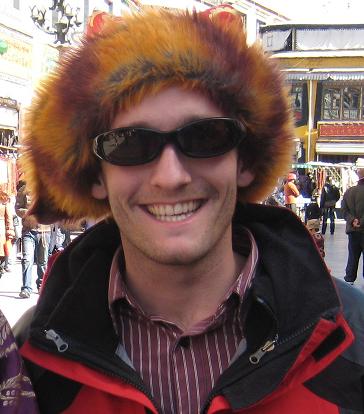What we learned from our guide and how he perceives life in Tibet with the top 2 spiritual leaders in exile.

Tibetan man and Me in Lhasa
Talking to Tibetans about how they see modern Tibet is something I’ve wanted to do for quite some time now. I often discuss modern China with Taiwanese, because they also live in a politically sticky environment. Superficially, Taiwan is considered a renegade province of China but their license plates say “台湾省” (Taiwan Province). There are also noticeably squeamish times of the year when international sporting events encompass all of Asia. Taiwan becomes “Chinese Taipei” and their flag is often an Olympic symbol on top of a white background. And as Mainland China grows its clout around the world, it is fair to say that fewer and fewer countries will recognize Taiwan as they once did decades ago.
But back to Tibet! The Lonely Planet guide doesn’t recall the Chinese history of Tibet in as bright a light as Chinese history books. For the Chinese, Tibet “has always been a part of China”; for Western historians, Tibet has been fighting foreign powers for centuries to keep its independence. In fact, two separate dynasties of China maintained territorial control over Tibet, and that is why The Party claimed Tibet after the civil war with the KMT (Kuo Min Tang: the previous Chinese government, which fled to modern Taiwan).

Me, Gyaltsen, and Jake at Potala Palace
Cut to present-day Lhasa City, February 2011, Gyaltsen: Our tour guide was a sweet, friendly man who seemed to genuinely appreciate our visit. He wrestled with his English but was still very informative. I could tell through indirect comments that he wanted to express the local people’s struggle with the military presence in their society. Platoons of soldiers, heavily armed, march around the squares of the most important religious sites in Lhasa. It was a bizarre, conflicting scene that could only be believed in person. At one side you see a man prostrating painfully around Jokang Temple, and to the other side you see helmets and shiny weapons.
When I asked Gyaltsen “How do Tibetan’s think about their lives today as compared to years gone by…?” He carefully answered, “there is more pressure now, but people still pray and go about their daily lives.” When my cousin Jake asked about the money flooding into Tibet, he replied “it makes people’s living better, but it also makes life harder.”

Monks in Shigatse's Monastery
From what I could see around the city and in small towns, Tibetans don’t necessarily care for the blue jeans and light beer being pushed on them from outside. They live hard lives, but that is what believers in Tibetan Buddhism prefer. When there was a chance for independence in the early 1900s, the Dalai Llama fought the conservatives who said that they didn’t have to militarize the country. They didn’t want to “modernize”… to their own peril we now see. They wanted simple lives, even if their spiritual leaders were sitting comfortably high up on their thrones.
In order to understand Tibet, you need to be familiar with their religion and the political influence of the Lamas (high priests of Tibetan Buddhism, which are reincarnations of various Buddhas). The two major lamas being “Dalai” (Avalokiteśvara = Compassion buddha) and “Panchen” (Amitabha=Great Scholar), but living in exile these days. The 14th Dalai lama is older and more famous than any other current lama. As he approaches his final years, the people will rely heavily on the Panchen lama to influence the choosing of a new spiritual leader. Unfortunately, the Panchen lama vanished from the public eye in 1995[*], and the Beijing appointed lama is finishing highschool in Beijing. Tibetan leaders will be never again be chosen as in the past, but rather, based on who will follow Beijing policies. Although Tibet is without a doubt part of modern China, this mysterious, once-isolated culture will only become more watered down as time passes by.
Tibet is a beautiful landscape which is a must for anyone’s bucket list. Even in dusty winter-time, the roof of the world is truly spectacular. Although a lot of artifacts and buildings were lost or destroyed during the Cultural Revolution, their culture is still very strong. Gyaltsen told us that March is when the Tibetan New Year is held, which is also called the King’s New Year (as opposed to the Peasants’ New Year, on the Chinese calendar). With tongue in cheek, as always, the people of Tibet will always be a humble people who welcome the world to see their beautiful home; which certainly is a treasure to the human race.
Related posts:
- Tibet Trip 2011 Caught on Tape! During the Chinese new year of 2011, I traveled with my brother (Nick) and cousin (Jake) through Hong Kong,...
- Ben’s Five Year Plan: 2011-2015 The Chinese 12th Five-Year Plan (FYP) is being decided upon by the National People’s Congress this month; March 2011....
- Vibrating Mode: Earthquakes Around Asia 2011 It seems every couple days there is another earthquake punching holes in the topography of Asia, and across the...
- Chinese Education in 2011 The New Year has passed in the West, but we are gearing up for a the Year of the...
- Macau 2011: Legend of the Dragon Boat Races Where the Dragons Sleep Dragons are often thought of as mystical creatures which guard castles and evildoers in western...



 Contact Me: ben@asianliving.me
Contact Me: ben@asianliving.me